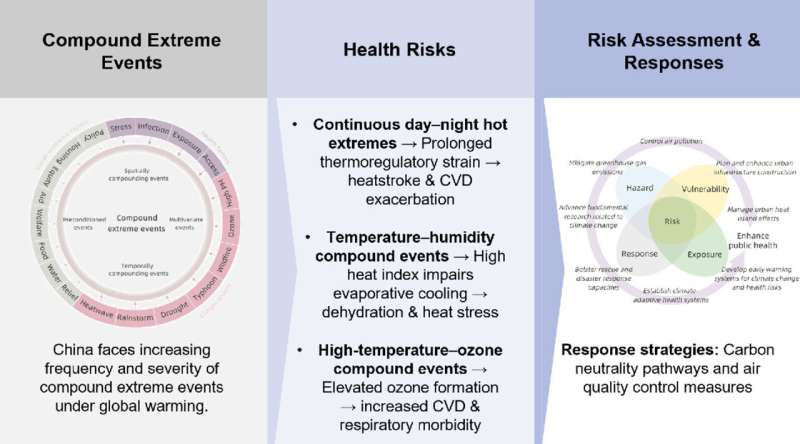Compound extreme events and associated health risks in China, along with assessment and response strategies. Credit: Haosu Tang
The Silent Storm Brewing
In recent years, China has faced a surge of extreme weather events—scorching heatwaves, devastating floods, and choking air pollution. While each poses significant challenges, their simultaneous occurrence creates a perilous synergy, amplifying their individual impacts. This convergence, known as “compound extreme events,” is emerging as a formidable threat to public health.
Decoding Compound Extremes
Compound extreme events refer to multiple climate hazards occurring together or in quick succession. Unlike isolated incidents, these overlapping disasters can exacerbate each other’s effects, leading to more severe outcomes. For instance, a heatwave can intensify air pollution levels, while flooding can spread contaminants, compounding health risks.
A comprehensive review led by researchers from the University of Sheffield and the Chinese Academy of Sciences delves into this phenomenon. Published in Atmospheric and Oceanic Science Letters, the study categorizes these events into three primary types:
Continuous Day–Night Heatwaves
Health Impacts:
Prolonged periods where temperatures remain high both day and night, preventing the body from recovering and increasing heat-related illnesses.
Temperature–Humidity Extremes
Health Impacts:
High temperatures combined with elevated humidity levels can hinder the body’s ability to cool itself, leading to heat stress.
Heat and Ozone Pollution Events
Health Impacts:
Elevated temperatures can increase ground-level ozone formation, exacerbating respiratory issues and leading to long-term health complications.
Vulnerable Populations at Greater Risk
The study highlights that certain groups are disproportionately affected by these compound events:
- Elderly Individuals: Age-related physiological changes make it harder to cope with extreme conditions.
- People with Pre-existing Health Conditions: Those with respiratory or cardiovascular diseases are more susceptible to compounded health effects.
- Low-Income Communities: Limited access to healthcare and adaptive resources increases vulnerability.
Charting a Path Forward
To address the escalating threat of compound extreme events, the researchers propose a multifaceted approach:
1. Risk Chain Identification
Understanding how different climate events interact and amplify each other.
2. Enhanced Data Collection
Improving observational records and modeling to predict compound events more accurately.
3. Driver Analysis
Investigating the underlying causes and contributing factors of these events.
4. Mitigation Strategies
Implementing measures to reduce greenhouse gas emissions and improve air quality.
5. Interdisciplinary Collaboration
Encouraging cooperation across sectors and regions to develop comprehensive solutions.
A Call to Action
“Most health risk assessments have focused on one type of hazard at a time,” notes lead author Haosu Tang. “But in reality, people are increasingly exposed to multiple extremes at once—and these compound events interact in ways that intensify health threats.”
As climate change continues to accelerate, the frequency and intensity of compound extreme events are expected to rise. Recognizing and preparing for these overlapping disasters is crucial to safeguarding public health.
What Can You Do?
Curious about how compound climate events might affect your region? Explore our interactive map to see potential risks and learn how to prepare.
Daily science news 2025, Best science blogs 2025, New science research 2025, Popular science articles, Latest science news 2025
Daily science news 2025, Best science blogs 2025, New science research 2025, Popular science articles, Latest science news 2025










